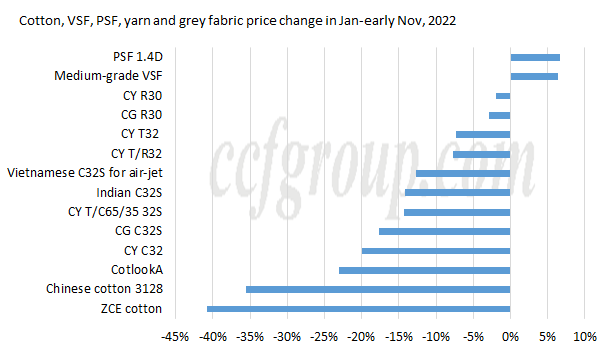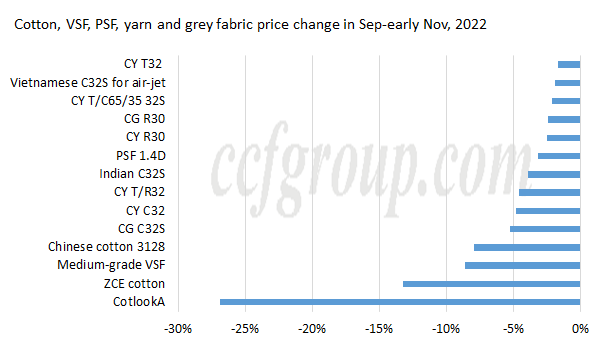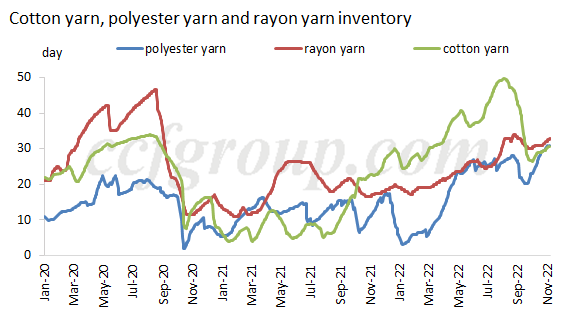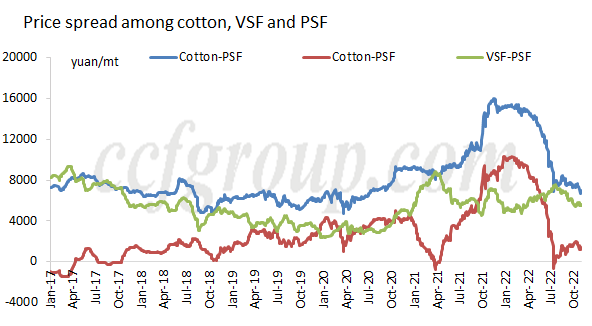Price and inventory comparison of three major cotton textile feedstock and yarn
Cotton industrial chain prices witness the largest decrease in 2022
Cotton textile market experiences a difficult year in 2022, with the demand restrained by multiple outbreaks of the epidemic, inflation, Russia-Ukraine war and the U.S. ban on Xinjiang cotton. Cotton industrial chain becomes the worst variety. ZCE cotton futures have dipped over 40% compared with the beginning of the year.

Cotton, cotton yarn and cotton grey fabric prices had lager decrease. Only VSF and PSF prices rose slightly compared with the early period of 2022, while other product prices all dropped. The price change from 2022/23 crop year is showed below (from Sep, 2022).

From Sep to early Nov, prices of major cotton textile feedstock (cotton, PSF and VSF), yarn and grey fabric all went downward, especially international cotton price and ZCE cotton futures, followed by VSF, and China spot cotton price had smaller decrease. Among the three major cotton textile feedstock, VSF price decrease was larger than cotton, and PSF price saw the lowest reduction. Viewed from the industrial chain, yarn and grey fabric price decrease was smaller than feedstock.
De-stocking and capital recouping is the theme and inventory begins to accumulate from Oct
Sep and Oct are the traditional textile buoyant season, but why the cotton textile product prices move lower significantly? It was mainly because the market was dominated by de-stocking and capital recouping with weak downstream demand and accumulating inventory.

Before the coming traditional buoyant season, inventory of cotton yarn, polyester yarn and rayon yarn was all at a high level, especially cotton yarn, its inventory has reached 50 days, facing obvious pressure. Polyester yarn inventory was at a three-year high level, and rayon yarn inventory was also high. Therefore, de-stocking was the main task for spinners in buoyant season. Fabric mills witnessed weakening sales in Oct and inventory also piled up gradually.
Substitution effect weakens in H2, and whether cotton will replace PSF and VSF is to be observed

In the second half year of 2021, price spread between cotton and PSF and between cotton and VSF continued to enlarge. Price spread between cotton and VSF once surpassed 10,000yuan/mt, and that between cotton and PSF reached high of 16,000yuan/mt. Under the great price gap, downstream spinners began to use VSF and PSF instead of cotton. However, in 2022, the price spread narrows gradually, and the substitution effect weakens in the second half year. Currently, price spread has been low. Then will cotton replace PSF and VSF instead? In short, cotton yarn, polyester yarn and rayon yarn profits are not satisfying and downstream orders lack. Moreover, U.S. ban on Xinjiang cotton products impact the cotton product export orders, which is one of the factor to be considered.
Conclusion: in 2022, cotton textile industrial chain faces great pressure in terms of price, inventory and operating rate. After the significant fall, is there any opportunity? Currently, new cotton is arriving on the market. The transportation and circulation is affected by the epidemic, and supply outside Xinjiang is tight. But cotton supply is sufficient overall and the pressure is delayed. Both Chinese and international cotton prices are volatile recently, making downstream plants more difficult in operation.
- Top keywords
- Cotton Price
- Cotton Futures Price
- Cotton Futures
- CZCE
- PTA Futures Price
- Chemical Fiber
- Polyester Prices
- Wool price
- PTA Futures
- Shengze Silk
- China
- Yarn Price
- price
- China Textile City
- Fibre Price
- Benzene Price
- Cotton
- Index
- Cotton Index
- PTA
- fabric price
- NYMEX
- Top 10
- textile industry
- Spot Cotton
- Cotton Yarn
- Polyester Price
- Futures
- PTA Price
- cotton yarn price

